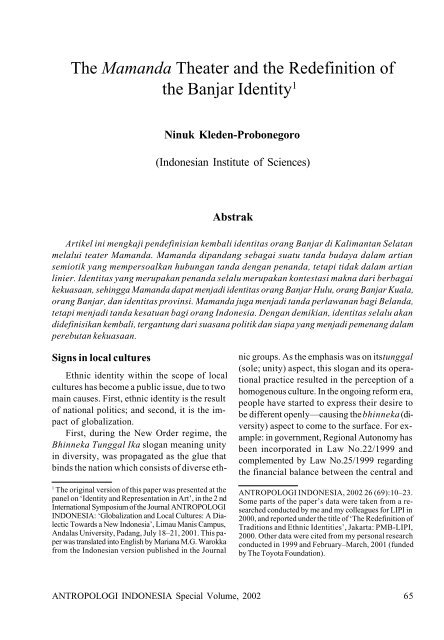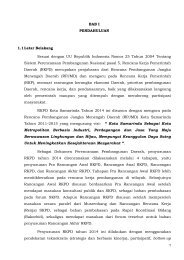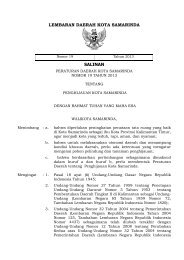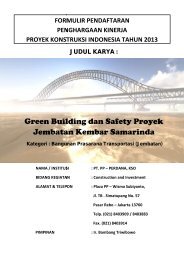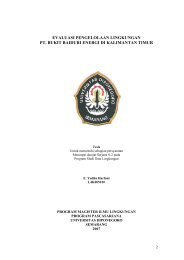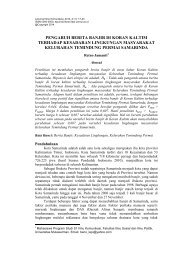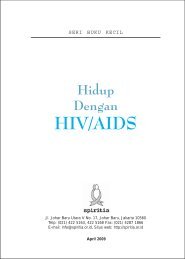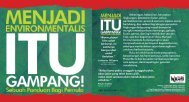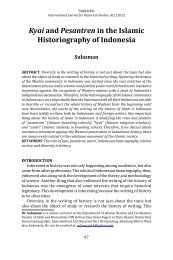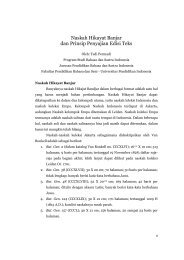The Mamanda Theater and the Redefinition of the Banjar Identity
The Mamanda Theater and the Redefinition of the Banjar Identity
The Mamanda Theater and the Redefinition of the Banjar Identity
Create successful ePaper yourself
Turn your PDF publications into a flip-book with our unique Google optimized e-Paper software.
<strong>The</strong> <strong>Mam<strong>and</strong>a</strong> <strong>The</strong>ater <strong>and</strong> <strong>the</strong> <strong>Redefinition</strong> <strong>of</strong><br />
<strong>the</strong> <strong>Banjar</strong> <strong>Identity</strong> 1<br />
Ninuk Kleden-Probonegoro<br />
(Indonesian Institute <strong>of</strong> Sciences)<br />
Abstrak<br />
Artikel ini mengkaji pendefinisian kembali identitas orang <strong>Banjar</strong> di Kalimantan Selatan<br />
melalui teater <strong>Mam<strong>and</strong>a</strong>. <strong>Mam<strong>and</strong>a</strong> dip<strong>and</strong>ang sebagai suatu t<strong>and</strong>a budaya dalam artian<br />
semiotik yang mempersoalkan hubungan t<strong>and</strong>a dengan pen<strong>and</strong>a, tetapi tidak dalam artian<br />
linier. Identitas yang merupakan pen<strong>and</strong>a selalu merupakan kontestasi makna dari berbagai<br />
kekuasaan, sehingga <strong>Mam<strong>and</strong>a</strong> dapat menjadi identitas orang <strong>Banjar</strong> Hulu, orang <strong>Banjar</strong> Kuala,<br />
orang <strong>Banjar</strong>, dan identitas provinsi. <strong>Mam<strong>and</strong>a</strong> juga menjadi t<strong>and</strong>a perlawanan bagi Bel<strong>and</strong>a,<br />
tetapi menjadi t<strong>and</strong>a kesatuan bagi orang Indonesia. Dengan demikian, identitas selalu akan<br />
didefinisikan kembali, tergantung dari suasana politik dan siapa yang menjadi pemenang dalam<br />
perebutan kekuasaan.<br />
Signs in local cultures<br />
Ethnic identity within <strong>the</strong> scope <strong>of</strong> local<br />
cultures has become a public issue, due to two<br />
main causes. First, ethnic identity is <strong>the</strong> result<br />
<strong>of</strong> national politics; <strong>and</strong> second, it is <strong>the</strong> impact<br />
<strong>of</strong> globalization.<br />
First, during <strong>the</strong> New Order regime, <strong>the</strong><br />
Bhinneka Tunggal Ika slogan meaning unity<br />
in diversity, was propagated as <strong>the</strong> glue that<br />
binds <strong>the</strong> nation which consists <strong>of</strong> diverse eth-<br />
1 <strong>The</strong> original version <strong>of</strong> this paper was presented at <strong>the</strong><br />
panel on ‘<strong>Identity</strong> <strong>and</strong> Representation in Art’, in <strong>the</strong> 2 nd<br />
International Symposium <strong>of</strong> <strong>the</strong> Journal ANTROPOLOGI<br />
INDONESIA: ‘Globalization <strong>and</strong> Local Cultures: A Dialectic<br />
Towards a New Indonesia’, Limau Manis Campus,<br />
Andalas University, Padang, July 18–21, 2001. This paper<br />
was translated into English by Mariana M.G. Warokka<br />
from <strong>the</strong> Indonesian version published in <strong>the</strong> Journal<br />
nic groups. As <strong>the</strong> emphasis was on its tunggal<br />
(sole; unity) aspect, this slogan <strong>and</strong> its operational<br />
practice resulted in <strong>the</strong> perception <strong>of</strong> a<br />
homogenous culture. In <strong>the</strong> ongoing reform era,<br />
people have started to express <strong>the</strong>ir desire to<br />
be different openly—causing <strong>the</strong> bhinneka (diversity)<br />
aspect to come to <strong>the</strong> surface. For example:<br />
in government, Regional Autonomy has<br />
been incorporated in Law No.22/1999 <strong>and</strong><br />
complemented by Law No.25/1999 regarding<br />
<strong>the</strong> financial balance between <strong>the</strong> central <strong>and</strong><br />
ANTROPOLOGI INDONESIA, 2002 26 (69):10–23.<br />
Some parts <strong>of</strong> <strong>the</strong> paper’s data were taken from a researched<br />
conducted by me <strong>and</strong> my colleagues for LIPI in<br />
2000, <strong>and</strong> reported under <strong>the</strong> title <strong>of</strong> ‘<strong>The</strong> <strong>Redefinition</strong> <strong>of</strong><br />
Traditions <strong>and</strong> Ethnic Identities’, Jakarta: PMB-LIPI,<br />
2000. O<strong>the</strong>r data were cited from my personal research<br />
conducted in 1999 <strong>and</strong> February–March, 2001 (funded<br />
by <strong>The</strong> Toyota Foundation).<br />
ANTROPOLOGI INDONESIA Special Volume, 2002 65
egional governments. <strong>The</strong>refore, regional autonomy,<br />
cultural plurality, heterogeneity, <strong>and</strong><br />
ethnicity have become heated issues.<br />
Second, globalization is a cultural movement<br />
stimulated by economic development <strong>and</strong><br />
global communication. <strong>The</strong>refore, on <strong>the</strong> one<br />
h<strong>and</strong>, globalization can be seen as a phenomenon<br />
that tends to be universal but, on <strong>the</strong> o<strong>the</strong>r<br />
h<strong>and</strong>, it stimulates responses towards streng<strong>the</strong>ning<br />
local identities. This is quite underst<strong>and</strong>able<br />
due to <strong>the</strong> dialectic relationship between<br />
<strong>the</strong> global <strong>and</strong> local worlds. For example, it is<br />
because <strong>the</strong>re are local cultures that could be<br />
turned into tourist objects that foreign tourists<br />
visit Indonesia.<br />
Since local identities are becoming stronger,<br />
whereas differences in each local culture<br />
should be preserved <strong>and</strong> even created if necessary,<br />
cultural differences can motivate <strong>and</strong><br />
stimulate <strong>the</strong> learning process for a better underst<strong>and</strong>ing<br />
<strong>of</strong> ourselves. <strong>The</strong> emergence <strong>of</strong><br />
cultural plurality, heterogeneity, <strong>and</strong> ethnicity<br />
will counterbalance <strong>the</strong> impacts <strong>of</strong> globalization.<br />
One <strong>of</strong> <strong>the</strong> forms <strong>of</strong> local cultures is <strong>the</strong><br />
<strong>Mam<strong>and</strong>a</strong> <strong>The</strong>ater <strong>of</strong> <strong>the</strong> <strong>Banjar</strong> people 2 , which<br />
can be treated as a cultural sign. This opinion<br />
derives from a semiotic approach 3 questioning<br />
<strong>the</strong> relationship between sign <strong>and</strong> signifier.<br />
Semiotics questions <strong>the</strong> relationship between<br />
a sign <strong>and</strong> what is signified by such sign. Placing<br />
<strong>the</strong> <strong>Mam<strong>and</strong>a</strong> <strong>The</strong>ater as a cultural sign has<br />
a <strong>the</strong>oretical consequence requiring people to<br />
2 South Kalimantan, where <strong>Banjar</strong> people live, has large<br />
rivers with many tributaries. <strong>The</strong>se rivers run from <strong>the</strong><br />
inl<strong>and</strong> to <strong>the</strong> estuary. <strong>The</strong>refore, <strong>Banjar</strong> people are also<br />
geographically classified, namely <strong>Banjar</strong> Kuala people<br />
living in <strong>the</strong> estuary, <strong>the</strong> intersections <strong>of</strong> two rivers, <strong>and</strong><br />
along <strong>the</strong> Martapura River in Martapura, <strong>Banjar</strong>masin <strong>and</strong><br />
Pleihari, <strong>and</strong> <strong>Banjar</strong> Hulu people that can be found in <strong>the</strong><br />
regencies <strong>of</strong> Tapin, Hulu Sungai Selatan, Hulu Sungai<br />
Tengah, Hulu Sungai Utara, <strong>and</strong> in <strong>the</strong> administrative area<br />
<strong>of</strong> Tabalong regency.<br />
3 In linguistics, semiotics is known as a science <strong>of</strong> signs<br />
that differs from <strong>the</strong> science <strong>of</strong> meaning (Mulyono<br />
1980:805,909).<br />
relate it to signifier <strong>and</strong> <strong>the</strong> signified. <strong>The</strong> relationship<br />
between a signifier <strong>and</strong> <strong>the</strong> signified<br />
does not denote a singular <strong>and</strong> linear<br />
meaning. 4 However, <strong>the</strong> meaning obtained depends<br />
on ‘<strong>the</strong> act <strong>of</strong> signifying’ (Derrida 1984).<br />
This means that <strong>the</strong> signifying process becomes<br />
essential in defining <strong>the</strong> relationship between<br />
<strong>the</strong> signifier <strong>and</strong> <strong>the</strong> signified party. Such relationship<br />
is nei<strong>the</strong>r linear nor final that cannot<br />
be interpreted. Friedman (1994) sees <strong>the</strong> importance<br />
<strong>of</strong> reinterpreting <strong>the</strong> meaning <strong>of</strong> a<br />
cultural sign that is subsequently considered<br />
as identity. In o<strong>the</strong>r words, identity is always a<br />
contest <strong>of</strong> discourses. We could say that <strong>the</strong><br />
repositioning <strong>of</strong> cultural signs treated as identity<br />
is always <strong>of</strong> political nature.<br />
This paper examines <strong>the</strong> way <strong>the</strong> <strong>Mam<strong>and</strong>a</strong><br />
<strong>The</strong>ater—as a cultural sign—plays its role in<br />
<strong>the</strong> redefinition process <strong>of</strong> <strong>the</strong> <strong>Banjar</strong> people’s<br />
identity. This analysis departs from <strong>the</strong> national<br />
issue on regional autonomy. Ever since <strong>the</strong> regional<br />
autonomy issue emerged, regions have<br />
started to display <strong>the</strong>ir regional identities; even<br />
at <strong>the</strong> Regency or Municipality levels. 5 <strong>The</strong><br />
analysis regarding identity begins with <strong>the</strong> review<br />
<strong>of</strong> two important events considered as <strong>the</strong><br />
turning point for <strong>the</strong> <strong>Banjar</strong> people in discussing<br />
<strong>the</strong>ir identity. <strong>The</strong> discussion goes on by<br />
examining <strong>Mam<strong>and</strong>a</strong> as a <strong>Banjar</strong> <strong>the</strong>ater, questioning<br />
‘what’ is <strong>Mam<strong>and</strong>a</strong> <strong>and</strong> ‘why’ was<br />
<strong>Mam<strong>and</strong>a</strong> born in <strong>the</strong> <strong>Banjar</strong> culture. One <strong>of</strong><br />
<strong>the</strong> main factors in this regard is <strong>the</strong> touch <strong>of</strong><br />
power on <strong>Mam<strong>and</strong>a</strong>. In this paper, <strong>the</strong> redefinition<br />
process <strong>of</strong> <strong>the</strong> <strong>Banjar</strong> identity through<br />
<strong>Mam<strong>and</strong>a</strong> is an unfinished contestation <strong>of</strong><br />
meaning.<br />
4 Such as <strong>the</strong> word ‘table’ that can be directly related to<br />
its signifier in <strong>the</strong> form <strong>of</strong> a four-legged flat object <strong>the</strong> top<br />
<strong>of</strong> which can be used for working (writing, drawing, eating,<br />
etc.).<br />
5 As an example, in mid 2001, <strong>the</strong> Mataram Municipality<br />
Tourism <strong>and</strong> Cultural Service Office, assisted by its artists,<br />
was occupied with inventing a dance that can be used<br />
as an identity characteristic for Mataram Municipality.<br />
ANTROPOLOGI INDONESIA Special Volume, 2002 66
‘Dialogue between generations’ <strong>and</strong><br />
Aruh Ganal: <strong>the</strong> debated identity turning<br />
points<br />
At <strong>the</strong> time this research was conducted,<br />
<strong>the</strong> Regional Government <strong>of</strong> South Kalimantan<br />
was busy preparing itself for introducing Regional<br />
Autonomy. One <strong>of</strong> <strong>the</strong> measures taken<br />
by <strong>the</strong> Regional Government <strong>of</strong> South<br />
Kalimantan was ga<strong>the</strong>ring ideas from <strong>Banjar</strong><br />
people living outside South Kalimantan cities.<br />
This was related to a series <strong>of</strong> activities commemorating<br />
Indonesian Independence Day <strong>and</strong><br />
<strong>the</strong> anniversary <strong>of</strong> <strong>the</strong> City <strong>of</strong> <strong>Banjar</strong>masin.<br />
<strong>The</strong>re were two important events in relation to<br />
<strong>the</strong> aforementioned plan <strong>of</strong> <strong>the</strong> Regional Government<br />
related indirectly to <strong>the</strong> identity <strong>of</strong> <strong>the</strong><br />
<strong>Banjar</strong> people, namely <strong>the</strong> ‘Dialogue between<br />
Generations’ seminar (August 8, 2000), <strong>and</strong> a<br />
gr<strong>and</strong> convention among <strong>the</strong> <strong>Banjar</strong> people, in<br />
local terms called Aruh Ganal (August 10,<br />
2000). Literally, Aruh Ganal means a gr<strong>and</strong><br />
feast—aruh means feast or party, <strong>and</strong> ganal<br />
means gr<strong>and</strong>.<br />
Aruh Ganal was attended by <strong>the</strong> <strong>Banjar</strong><br />
people not only from major cities in Java such<br />
as Jakarta, Yogyakarta, <strong>and</strong> Surabaya, but also<br />
by people from various places in Sumatra, particularly<br />
from Tembilahan. <strong>Banjar</strong> people have<br />
settled for several generations in Tembilahan.<br />
<strong>Banjar</strong> people from Malaysia, Singapore, <strong>and</strong><br />
Brunei also attended.<br />
<strong>The</strong> Aruh Ganal, which was opened by <strong>the</strong><br />
President, did raise controversies among <strong>the</strong><br />
<strong>Banjar</strong> people <strong>the</strong>mselves. Several groups opposed<br />
Aruh Ganal for two reasons, namely<br />
funding <strong>and</strong> ethnic sentiments. Several parties<br />
were <strong>of</strong> <strong>the</strong> opinion that <strong>the</strong> convention was<br />
only a waste <strong>of</strong> money. If it was intended to<br />
ga<strong>the</strong>r ideas from <strong>the</strong> <strong>Banjar</strong> people, why<br />
couldn’t <strong>the</strong>y just hold a discussion with opinion<br />
leaders living in South Kalimantan, including<br />
lecturers at Lambung Mangkurat University?<br />
O<strong>the</strong>rs thought that <strong>the</strong> Organizing Com-<br />
mittee was not being sufficiently transparent.<br />
<strong>The</strong>y were concerned that <strong>the</strong> expenses <strong>of</strong> <strong>the</strong><br />
convention would affect <strong>the</strong> Regional Budget<br />
(Anggaran Pendapatan dan Belanja Daerah,<br />
APBD). OKP <strong>and</strong> public organizations were<br />
not in favor <strong>of</strong> <strong>the</strong> organizing committee <strong>of</strong> <strong>the</strong><br />
gr<strong>and</strong> convention ei<strong>the</strong>r, saying that <strong>the</strong>y ‘were<br />
not indigenous <strong>Banjar</strong> people’. Some student<br />
groups even asked for approval to hold protests<br />
against <strong>the</strong> gr<strong>and</strong> convention. ( Kom<strong>and</strong>an<br />
Kom<strong>and</strong>o Resimen, DANREM) had no objection<br />
to approve <strong>the</strong> anti Aruh Ganal protests,<br />
provided that <strong>the</strong>y would not disrupt <strong>the</strong><br />
President’s visit. However, he did not approve<br />
any counter protest groups.<br />
Governor H.M. Syahriel Darhan, accompanied<br />
by <strong>the</strong> chairperson <strong>of</strong> <strong>the</strong> organizing<br />
committee for <strong>the</strong> gr<strong>and</strong> convention, visited<br />
K.H. Zaini Abdul Ghani, also known as Guru<br />
Ijai (Master Ijai). This teacher from Sekumpul<br />
Village is well known for his charisma <strong>and</strong> supernatural<br />
power, 6 so that many <strong>of</strong>ficials, not<br />
only from South Kalimantan, but also from<br />
Jakarta, came to ask for his blessings. Guru Ijai<br />
advised <strong>the</strong> Governor <strong>and</strong> <strong>the</strong> organizing committee<br />
on <strong>the</strong> convention: ‘Aruh Ganal Positif<br />
Asalkan Jangan Bahiri-hirian’ as reported by<br />
<strong>the</strong> Kalimantan Post daily newspaper (Tuesday,<br />
August 8, 2000). Guru Ijai blessed <strong>the</strong><br />
gr<strong>and</strong> convention as long as <strong>the</strong>re was no jealousy<br />
among <strong>the</strong> people. Bahiri-hirian means<br />
jealousy among various groups. For example,<br />
between <strong>Banjar</strong> people living outside<br />
Kalimantan (who were being asked for <strong>the</strong>ir<br />
contribution <strong>of</strong> ideas) <strong>and</strong> those living in<br />
<strong>Banjar</strong>masin; between those sitting <strong>and</strong> not sitting<br />
in <strong>the</strong> organizing committee; between those<br />
who consider <strong>the</strong>mselves as indigenous <strong>Banjar</strong><br />
people <strong>and</strong> those who are not indigenous <strong>Banjar</strong><br />
people.<br />
6 See, for instance, <strong>the</strong> chapter on ‘Tuan Guru <strong>and</strong> Habib’,<br />
in Kleden-Probonegoro <strong>and</strong> Zultanawar (1996:80–84).<br />
ANTROPOLOGI INDONESIA Special Volume, 2002 67
<strong>The</strong> relation between <strong>the</strong> seminar, <strong>the</strong> convention<br />
<strong>and</strong> <strong>the</strong> identity <strong>of</strong> <strong>Banjar</strong> people is<br />
evident from <strong>the</strong> subject <strong>of</strong> <strong>the</strong> debate. <strong>The</strong><br />
seminar on <strong>the</strong> ‘Dialogue between Generations’<br />
included <strong>the</strong> <strong>the</strong>me <strong>of</strong> Baimbai Manyusuri Sisi<br />
Tapih 7 , which literally means tying <strong>the</strong> edges<br />
<strong>of</strong> a sarong toge<strong>the</strong>r. <strong>The</strong> one-day seminar, organized<br />
by <strong>the</strong> organizing committee for <strong>the</strong><br />
anniversary <strong>of</strong> South Kalimantan Province in<br />
collaboration with Lembaga Budaya <strong>Banjar</strong><br />
(<strong>Banjar</strong> Cultural Institution), spelled out <strong>the</strong><br />
aforementioned <strong>the</strong>me in <strong>the</strong> form <strong>of</strong> papers<br />
regarding cultural issues, particularly <strong>Banjar</strong><br />
ethics. <strong>The</strong> papers, mostly written by members<br />
<strong>of</strong> <strong>the</strong> older generation, generally revealed <strong>the</strong>ir<br />
concern <strong>of</strong> <strong>the</strong> younger generation, who are<br />
considered to be ignorant <strong>of</strong> <strong>the</strong> <strong>Banjar</strong> traditions<br />
<strong>and</strong> customs, including its courtesy.<br />
8 Representatives <strong>of</strong> <strong>the</strong> younger generation,<br />
unlike <strong>the</strong> previous three paper presenters,<br />
were not concerned about <strong>the</strong> cultural<br />
changes in line with newer, more pragmatic<br />
values. <strong>The</strong>re were five commission sessions<br />
(economy, business <strong>and</strong> <strong>the</strong> environment,<br />
socio-politics <strong>and</strong> law, socio-cultural affairs,<br />
education <strong>and</strong> health, as well as religion) <strong>and</strong> a<br />
plenary session in <strong>the</strong> two-day Aruh Ganal.<br />
One <strong>of</strong> <strong>the</strong> issues raised in <strong>the</strong> socio-cultural<br />
commission was <strong>the</strong> concern that globalization<br />
7 <strong>Banjar</strong>masin Municipality has a jargon easily read in<br />
many places: at <strong>the</strong> <strong>of</strong>fice <strong>of</strong> <strong>the</strong> Regional Government,<br />
hotels, signs <strong>of</strong> small sasirangan (South Kalimantan batik)<br />
industries, namely Kayuh Baimbai, meaning rowing<br />
<strong>the</strong> boat toge<strong>the</strong>r.<br />
8 As said by one <strong>of</strong> <strong>the</strong> paper presenters, in his neighborhood,<br />
children do not obey <strong>the</strong>ir parents anymore. Contrarily,<br />
he <strong>and</strong> his generation respected <strong>the</strong>ir parents very<br />
much. One <strong>of</strong> <strong>the</strong> younger participants answered: did it<br />
not pass in <strong>the</strong> mind <strong>of</strong> <strong>the</strong> speaker that young villagers<br />
are applying democracy starting to be taught in school,<br />
for instance: arguing opinions which is considered by <strong>the</strong><br />
parents as being disobedient <strong>and</strong> breaching <strong>the</strong> courtesy?<br />
Some people were also concerned about <strong>the</strong> Internet technology<br />
because <strong>the</strong> younger generation could easily open<br />
pornographic sites.<br />
could eliminate <strong>Banjar</strong> cultural assets. <strong>The</strong><br />
public fear that <strong>the</strong>ir culture would change was<br />
similar to <strong>the</strong> concern <strong>of</strong> <strong>the</strong> older generation<br />
in <strong>the</strong> ‘Dialogue between Generations’ seminar.<br />
<strong>The</strong> seminar with <strong>the</strong> Baimbai Manyusuri<br />
Tapih <strong>the</strong>me <strong>and</strong> <strong>the</strong> gr<strong>and</strong> convention <strong>of</strong> <strong>the</strong><br />
<strong>Banjar</strong> people demonstrated that <strong>the</strong> public are<br />
still discussing <strong>Banjar</strong> traditions <strong>and</strong> customs<br />
considered—by <strong>the</strong> older generation—as no<br />
longer understood by <strong>the</strong> younger generation.<br />
On <strong>the</strong> o<strong>the</strong>r h<strong>and</strong>, <strong>the</strong> younger generation was<br />
<strong>of</strong> <strong>the</strong> opinion that <strong>Banjar</strong> traditions <strong>and</strong> customs<br />
had to undergo changes. Actually, such<br />
changes have already occurred. This is obvious<br />
from how bubuhan 9 , as <strong>the</strong> basic concept<br />
<strong>of</strong> <strong>the</strong> <strong>Banjar</strong> kinship system, has undergone a<br />
change <strong>of</strong> meaning. Today, people recognize<br />
<strong>the</strong> bubuhan <strong>of</strong> traders, farmers, aristocrats, <strong>and</strong><br />
so forth, as stated by one <strong>of</strong> <strong>the</strong> speakers:<br />
‘Kalau kebetulan tampulu bakuasa, maka<br />
membentuk kroni bubuhan sendiri. Secara<br />
samar-samar keadaannya menjadi bubuhan<br />
nang sugih-sugih, nang badahi-dahi, nang<br />
ningrat-ningrat, nang pagawai nagri, nang<br />
alim-alim. Berikutnya menyusul bubuhan urang<br />
jaba, bubuhan tani, bubuhan paiwakan,<br />
panurih gatah.’<br />
‘If you happen to gain power, you will create<br />
your own bubuhan crony. Indistinctly, it will<br />
become <strong>the</strong> bubuhan <strong>of</strong> <strong>the</strong> wealthy, <strong>the</strong> high<br />
society, <strong>the</strong> aristocrats, <strong>the</strong> civil servants, <strong>the</strong><br />
pious people. <strong>The</strong>n follows <strong>the</strong> bububan <strong>of</strong><br />
urang jaba, farmers, fishermen, rubber tappers.’<br />
If <strong>the</strong> ‘Dialogue between Generations’ <strong>and</strong><br />
<strong>the</strong> Aruh Ganal are considered as cultural signs,<br />
<strong>the</strong> meaning <strong>of</strong> <strong>Banjar</strong> traditions <strong>and</strong> customs<br />
was being reinterpreted in <strong>the</strong>se two events. As<br />
Friedman (1994) said, <strong>the</strong> contestation <strong>of</strong> discourses,<br />
such as <strong>the</strong>se, must be observed in<br />
9 Literally, bubuhan means citizens or group. In Anthropology,<br />
those in one nuclear family, one extended family,<br />
or one village are usually called sebubuhan.<br />
ANTROPOLOGI INDONESIA Special Volume, 2002 68
order to analyze identity. <strong>Identity</strong> awareness<br />
does not seem to be a given object, but a discourse<br />
continuously open to interpretation <strong>and</strong><br />
debate by <strong>the</strong> community concerned.<br />
<strong>Mam<strong>and</strong>a</strong> as <strong>the</strong> <strong>Banjar</strong> <strong>the</strong>ater<br />
<strong>Mam<strong>and</strong>a</strong> has always been acknowledged<br />
as <strong>the</strong> <strong>the</strong>ater <strong>of</strong> <strong>the</strong> <strong>Banjar</strong> people, as <strong>of</strong>ten<br />
stated in various performance art festivals, organized<br />
both in South Kalimantan Province as<br />
well as in Jakarta. Before we answer <strong>the</strong> question<br />
why <strong>the</strong> <strong>Mam<strong>and</strong>a</strong> <strong>the</strong>ater has grown in<br />
<strong>the</strong> <strong>Banjar</strong> culture (<strong>and</strong> not, for example, in <strong>the</strong><br />
Betawi culture) we have to underst<strong>and</strong> <strong>the</strong> genealogy<br />
<strong>and</strong> characteristics <strong>of</strong> this <strong>the</strong>ater.<br />
Viewed from <strong>the</strong> aspect <strong>of</strong> etymology, <strong>the</strong><br />
word mam<strong>and</strong>a originates from <strong>the</strong> word mama<br />
<strong>and</strong> <strong>the</strong> suffix -nda. Mama is <strong>the</strong> affectionate<br />
form <strong>of</strong> <strong>the</strong> word marina, which in <strong>the</strong> <strong>Banjar</strong><br />
language means Uncle. In <strong>the</strong> performance, <strong>the</strong><br />
word mam<strong>and</strong>a is used by <strong>the</strong> King whenever<br />
he addresses <strong>the</strong> mangkubumi <strong>and</strong> <strong>the</strong> wazir<br />
(prime minister); mam<strong>and</strong>a mangkubumi <strong>and</strong><br />
mam<strong>and</strong>a wazir.<br />
We can say that this <strong>the</strong>ater shares <strong>the</strong> same<br />
roots with various forms <strong>of</strong> <strong>the</strong>aters in <strong>the</strong> Riau<br />
Isl<strong>and</strong>s; Wayang Bangsawan (PMB-LIPI<br />
1996), <strong>and</strong> <strong>the</strong> Mendu <strong>the</strong>ater in Natuna Isl<strong>and</strong>,<br />
Riau (PMB-LIPI 1996) that, according to information,<br />
is also found in West Kalimantan.<br />
Mendu uses a ladun (ladon in <strong>Mam<strong>and</strong>a</strong>). Both<br />
<strong>Mam<strong>and</strong>a</strong> <strong>and</strong> Mendu use similar properties.<br />
Both are performed in an arena, without a stage,<br />
using a table <strong>and</strong> two chairs to create an atmosphere,<br />
as well as a kingdom setting. <strong>The</strong>se<br />
characteristics are similar to those <strong>of</strong> <strong>the</strong> Mak<br />
Yong <strong>the</strong>ater (Syamsuddin 1981/1982; Pudentia<br />
2000), especially in <strong>the</strong> Riau Isl<strong>and</strong>s. We can<br />
also say that <strong>Mam<strong>and</strong>a</strong> shares <strong>the</strong> same roots<br />
with <strong>the</strong> Lenong <strong>the</strong>ater, particularly <strong>the</strong><br />
Lenong Denes (now extinct) <strong>of</strong> <strong>the</strong> Betawi<br />
people (Kleden-Probonegoro 1997). <strong>The</strong> simi-<br />
larity is in <strong>the</strong> usage <strong>of</strong> narration <strong>of</strong> <strong>the</strong> Arabian<br />
Nights with equipment similar to <strong>the</strong><br />
Mendu <strong>the</strong>ater. <strong>Mam<strong>and</strong>a</strong> is considered as sharing<br />
<strong>the</strong> same roots with Rudat <strong>The</strong>ater, also<br />
known as Kemidi Rudat (Suparman 1990;<br />
Kleden-Probonegoro 2000) in Lombok, because<br />
<strong>the</strong>ir narration consist <strong>of</strong> excerpts from<br />
hikayat (tales), such as Siti Zubaedah, Si Miskin<br />
(<strong>the</strong> Poor), <strong>and</strong> Raja Bagdad (<strong>the</strong> King <strong>of</strong><br />
Baghdad). In all <strong>of</strong> those <strong>the</strong>aters considered<br />
to be sharing <strong>the</strong> same roots, <strong>the</strong> actors wear<br />
clo<strong>the</strong>s like those worn by Malay royalty.<br />
Tan Sooi Beng (1993), an ethnomusicologist<br />
conducting a research on <strong>the</strong> Bangsawan<br />
<strong>the</strong>ater said that, being popular in <strong>the</strong> Malacca<br />
Peninsula around <strong>the</strong> 1880s, this Persian <strong>The</strong>ater<br />
influenced <strong>the</strong> nobility. At that time, <strong>the</strong>re<br />
lived a wealthy Persian man in Penang who<br />
established <strong>the</strong> Pushi Indra Bangsawan <strong>the</strong>ater<br />
company. Around <strong>the</strong> 1890s, <strong>the</strong>re were<br />
many types <strong>of</strong> <strong>the</strong>aters, originating from <strong>the</strong><br />
Bangsawan <strong>the</strong>ater <strong>and</strong> scattered throughout<br />
<strong>the</strong> Malacca Peninsula (Tan Sooie Beng<br />
1993:16). It is most likely that <strong>the</strong> Persian <strong>the</strong>ater<br />
influenced Komidi Bangsawan, <strong>the</strong> embryo<br />
<strong>of</strong> <strong>the</strong> <strong>Mam<strong>and</strong>a</strong> <strong>the</strong>ater. At <strong>the</strong> end <strong>of</strong> <strong>the</strong> 19 th<br />
century, <strong>the</strong> Malaccan Komedi Indra<br />
Bangsawan arrived in <strong>Banjar</strong>masin under <strong>the</strong><br />
leadership <strong>of</strong> Encik Ibrahim bin Wangsa <strong>and</strong><br />
his wife, Encik Hawa, to hold a one-month<br />
performance (S<strong>and</strong>erta 1997:2). In South<br />
Kalimantan—particularly in <strong>the</strong> Hulu Sungai<br />
area where <strong>the</strong> <strong>Banjar</strong> Hulu people live—<strong>the</strong><br />
<strong>Mam<strong>and</strong>a</strong>, originating from <strong>the</strong> aforementioned<br />
Komedi Bangsawan <strong>and</strong> <strong>the</strong> Persian <strong>the</strong>ater,<br />
appeared in two forms, namely Pariuk <strong>and</strong><br />
Tubau. <strong>The</strong>refore, <strong>Mam<strong>and</strong>a</strong> was initially<br />
known to come from <strong>the</strong> <strong>Banjar</strong> Hulu people,<br />
although it also developed in <strong>Banjar</strong>masin<br />
<strong>the</strong>reafter.<br />
<strong>Mam<strong>and</strong>a</strong> Pariuk, also known as <strong>Mam<strong>and</strong>a</strong><br />
Margasari (<strong>the</strong> name <strong>of</strong> <strong>the</strong> village considered<br />
to be <strong>the</strong> center <strong>of</strong> <strong>Mam<strong>and</strong>a</strong>), can be found in<br />
ANTROPOLOGI INDONESIA Special Volume, 2002 69
Tapin Regency, while <strong>Mam<strong>and</strong>a</strong> Tubau is concentrated<br />
in Tubau Village, Barabai, Hulu<br />
Sungai Tengah Regency. <strong>The</strong>re was an interesting,<br />
noteworthy field experience regarding<br />
<strong>the</strong> identity <strong>of</strong> <strong>the</strong> Pancar Rindang Banawa<br />
group in Pagat Village, Hulu Sungai Tengah<br />
Regency. <strong>The</strong> performance <strong>of</strong> this group is classified<br />
as a <strong>Mam<strong>and</strong>a</strong> Tubau, but when this<br />
matter was confirmed to an artist <strong>of</strong> Pancar<br />
Rindang Banawa, he refused to admit that. He<br />
said, ‘Well, our <strong>Mam<strong>and</strong>a</strong> is <strong>the</strong> local<br />
<strong>Mam<strong>and</strong>a</strong>, not Tubau’s.’ He seemed to feel<br />
quite proud <strong>of</strong> his village. <strong>The</strong> differences between<br />
<strong>Mam<strong>and</strong>a</strong> Pariuk <strong>and</strong> <strong>Mam<strong>and</strong>a</strong> Tubau<br />
are described in Table 1.<br />
<strong>Mam<strong>and</strong>a</strong> Pariuk—according to <strong>Banjar</strong><br />
people—originates from Pariuk Village,<br />
Margasari, <strong>and</strong> Tapin Regency. This area is located<br />
on <strong>the</strong> riverbank, unlike Tubau Village<br />
in Hulu Sungai Tengah Regency, which is an<br />
inl<strong>and</strong> area <strong>and</strong> does not have rivers. <strong>The</strong> natural<br />
environment affects <strong>the</strong> forms <strong>of</strong> <strong>the</strong><br />
<strong>Mam<strong>and</strong>a</strong> <strong>the</strong>ater. <strong>Mam<strong>and</strong>a</strong> Pariuk, originating<br />
from <strong>the</strong> riverbank area, has winding background<br />
music, just like <strong>the</strong> river that flows<br />
through this area. <strong>The</strong> background music <strong>of</strong> <strong>the</strong><br />
inl<strong>and</strong> <strong>Mam<strong>and</strong>a</strong> Tubau is short <strong>and</strong> mounting;<br />
just like <strong>the</strong> pace <strong>of</strong> people walking through<br />
<strong>the</strong> inl<strong>and</strong>. Differences are also found in <strong>the</strong><br />
types <strong>of</strong> narration.<br />
<strong>The</strong> narration <strong>of</strong> <strong>the</strong> <strong>Mam<strong>and</strong>a</strong> Pariuk <strong>the</strong>ater<br />
originates from hikayat, such as <strong>the</strong> Ara-<br />
Table 1<br />
<strong>Mam<strong>and</strong>a</strong> Pariuk <strong>and</strong> <strong>Mam<strong>and</strong>a</strong> Tubau<br />
bian Nights, Siti Zubaedah, Si Miskin (<strong>the</strong><br />
Poor), <strong>and</strong> Raja Bagdad (<strong>the</strong> King <strong>of</strong><br />
Baghdad). <strong>The</strong>se types <strong>of</strong> narration also appear<br />
in <strong>the</strong>ater performances in Riau Isl<strong>and</strong>s, such<br />
as Mak Yong <strong>and</strong> Bangsawan <strong>The</strong>aters, Lenong<br />
Denes <strong>of</strong> <strong>the</strong> Betawi people <strong>and</strong> Kemidi Rudat<br />
in Lombok Isl<strong>and</strong>. <strong>The</strong> aforementioned types<br />
<strong>of</strong> narration obviously have an Islamic nuance<br />
in line with <strong>the</strong> religious conduct <strong>of</strong> <strong>the</strong> <strong>Banjar</strong><br />
people, <strong>the</strong> <strong>Mam<strong>and</strong>a</strong> Pariuk community.<br />
<strong>The</strong> <strong>Mam<strong>and</strong>a</strong> Pariuk community in Tapin<br />
Regency has different religious conducts compared<br />
to <strong>the</strong> <strong>Mam<strong>and</strong>a</strong> Tubau community, although<br />
<strong>the</strong>y are both Moslem communities. <strong>The</strong><br />
Tapin community lives not far from Tuan-tuan<br />
<strong>Mam<strong>and</strong>a</strong> Pariuk <strong>Mam<strong>and</strong>a</strong> Tubau<br />
Distribution area Near <strong>the</strong> rivers Inl<strong>and</strong><br />
Tune <strong>of</strong> background music Winding Short, mounting<br />
Narration Hikayat, Poems Carang k<strong>and</strong>a<br />
Setting Kingdom Kingdom<br />
Performance structure Uses ladon<br />
Introduction by <strong>the</strong> company<br />
leader<br />
Guru Besar (religious mentors) <strong>and</strong> wellknown<br />
pesantren (Islamic boarding schools),<br />
as well as hallowed cemeteries <strong>of</strong> prominent<br />
figures around Martapura. In this area, people<br />
do not apply fundraising methods such as those<br />
practiced by <strong>the</strong> Pagat community (<strong>the</strong><br />
<strong>Mam<strong>and</strong>a</strong> Tubau community). 10<br />
<strong>Mam<strong>and</strong>a</strong> Tubau more <strong>of</strong>ten stages carang<br />
k<strong>and</strong>a, which is a narration prepared by <strong>the</strong><br />
director, although <strong>the</strong> community is familiar<br />
10 Fund raising is performed, for example, when repairing<br />
a mushola (small mosque) <strong>and</strong> a mosque by auctioning<br />
cakes <strong>and</strong> ending it with karaoke. Karaoke singers wear<br />
mini skirts or long tights with spaghetti-lined tank tops<br />
covering <strong>the</strong> upper part <strong>of</strong> <strong>the</strong>ir bodies. Cake buyers paying<br />
<strong>the</strong> most are allowed to dance with <strong>the</strong> karaoke singers.<br />
ANTROPOLOGI INDONESIA Special Volume, 2002 70
with <strong>the</strong> performed plot. 11 For example,<br />
Bergetarnya Tiang Aras, a legend in Hulu<br />
Sungai Tengah, was once performed by <strong>the</strong><br />
Pancar Rindang Banawa group to celebrate<br />
<strong>the</strong> 2001 Independence Day festival in Pagat.<br />
<strong>Mam<strong>and</strong>a</strong> Pariuk <strong>and</strong> Tubau use <strong>the</strong> same<br />
setting, namely a kingdom. This is easily understood<br />
because <strong>the</strong> areas where both<br />
<strong>Mam<strong>and</strong>a</strong> types come from used to be kingdoms.<br />
Tanjung Pura Kingdom, having its capital<br />
in Tanjung city (its contemporary name) was<br />
<strong>the</strong> oldest kingdom (7 th century) with an area<br />
covering <strong>the</strong> nor<strong>the</strong>rn part <strong>of</strong> South Kalimantan.<br />
<strong>The</strong>re were also Negara Dipa Kingdom (13 th<br />
century), C<strong>and</strong>i Agung in <strong>the</strong> Amuntai area,<br />
<strong>and</strong> Negara Daha related to Majapahit in Java;<br />
all <strong>of</strong> <strong>the</strong>m are <strong>the</strong> locations where <strong>Mam<strong>and</strong>a</strong><br />
Tubau is well-known. <strong>The</strong> area <strong>of</strong> <strong>the</strong> former<br />
kingdom <strong>of</strong> C<strong>and</strong>i Laras is <strong>the</strong> area <strong>of</strong><br />
<strong>Mam<strong>and</strong>a</strong> Pariuk.<br />
<strong>The</strong> aforementioned two types <strong>of</strong> <strong>Mam<strong>and</strong>a</strong><br />
have different ways <strong>of</strong> starting <strong>the</strong>ir performance.<br />
<strong>Mam<strong>and</strong>a</strong> Pariuk <strong>the</strong>ater uses <strong>the</strong> character<br />
<strong>of</strong> a ladon. Ladon is used as a noun, while<br />
<strong>the</strong> verb form is baladon, performed by three<br />
artists (five are also possible). In baladon, <strong>the</strong><br />
actors talk about <strong>the</strong> narration to be presented.<br />
In Pagat District (Hulu Sungai Tengah Regency),<br />
<strong>the</strong> <strong>Mam<strong>and</strong>a</strong> performance does not<br />
use a ladon. On <strong>the</strong> contrary, a person, usually<br />
<strong>the</strong> leader <strong>of</strong> <strong>the</strong> <strong>the</strong>ater company, narrates <strong>the</strong><br />
story to be performed in <strong>the</strong> play. This person<br />
mentions <strong>the</strong> names <strong>of</strong> <strong>the</strong> artists at <strong>the</strong> same<br />
time.<br />
It is attempted to underline <strong>the</strong> following<br />
matters in <strong>the</strong> aforementioned description:<br />
• <strong>the</strong>re are two types <strong>of</strong> <strong>Mam<strong>and</strong>a</strong> <strong>the</strong>aters,<br />
each having its own community;<br />
• <strong>the</strong>re is an Islamic nuance in <strong>the</strong> <strong>Mam<strong>and</strong>a</strong><br />
11 This form <strong>of</strong> narration is also known at <strong>the</strong> Lenong <strong>The</strong>ater<br />
<strong>of</strong> <strong>the</strong> Betawi people. Lenong has cerita karangan<br />
(different from cerita riwayat) just like <strong>the</strong> Kemidi Rudat<br />
in Lombok that also recognizes both types <strong>of</strong> narration.<br />
<strong>The</strong>ater, although in <strong>Mam<strong>and</strong>a</strong> Pariuk it<br />
seems to be more dominant compared to<br />
<strong>Mam<strong>and</strong>a</strong> Tubau;<br />
• geographical conditions also influence <strong>the</strong><br />
types <strong>of</strong> <strong>Mam<strong>and</strong>a</strong>; <strong>and</strong><br />
• <strong>the</strong> kingdom setting is an inseparable part<br />
<strong>of</strong> <strong>the</strong> <strong>the</strong>ater’s characteristics.<br />
<strong>The</strong>refore, it is obvious that <strong>the</strong> <strong>Mam<strong>and</strong>a</strong><br />
<strong>the</strong>ater would not emerge in <strong>the</strong> Irian culture<br />
or <strong>the</strong> Betawi culture which do not have kingdoms;<br />
or in <strong>the</strong> Sundanese culture, never directly<br />
touched by <strong>the</strong> Malay culture in its development<br />
process (ei<strong>the</strong>r through religion or<br />
<strong>the</strong> Persian <strong>and</strong> Bangsawan <strong>the</strong>ater traditions).<br />
Both forms <strong>of</strong> <strong>Mam<strong>and</strong>a</strong> <strong>the</strong>ater traditions<br />
can be found in <strong>the</strong> Hulu Sungai area, although<br />
since a traditional performance art festival held<br />
in Taman Ismail Marzuki (1970), <strong>the</strong> South<br />
Kalimantan Province has been sending a<br />
<strong>Mam<strong>and</strong>a</strong> form that is nei<strong>the</strong>r classified as<br />
Pariuk nor Tubau. This form can usually be<br />
found in <strong>Banjar</strong>masin such as <strong>the</strong> Teater<br />
<strong>Banjar</strong>masin Group, groups <strong>of</strong> Universitas<br />
Lambung Mangkurat students, etc. <strong>The</strong> form<br />
<strong>of</strong> this <strong>the</strong>ater performance is characterized by<br />
<strong>the</strong> constant use <strong>of</strong> ladon (a Pariuk characteristic)<br />
with a carang k<strong>and</strong>a narration (<strong>the</strong> Tubau<br />
characteristic, for example G<strong>and</strong>ut Bariah <strong>and</strong><br />
Ilmu Wan Tahta 12 ), whereas its specific feature<br />
is that <strong>the</strong> performance never exceeds one<br />
hour. 13<br />
12 G<strong>and</strong>ut Bariah is a story <strong>of</strong> a g<strong>and</strong>ut (a folkdancer,<br />
such as a ledek in Java or wayang cokek in Tangerang)<br />
usually valued negatively by <strong>the</strong> community, but she<br />
helped <strong>the</strong> struggle <strong>of</strong> <strong>the</strong> Indonesian armies by spying<br />
her Dutch master. Ilmu Wan Tahta is a story <strong>of</strong> a princess<br />
ready to be wed to a Mangkubumi, but she refuses since<br />
she still desires to continue her study. Suddenly, her school<br />
is burned down <strong>and</strong>, following investigation, it proves to<br />
have been <strong>the</strong> act <strong>of</strong> <strong>the</strong> Mangkubumi.<br />
13 Performances by <strong>Banjar</strong>masin groups tend to describe<br />
<strong>the</strong> <strong>Banjar</strong> identity when confronting o<strong>the</strong>r ethnic groups<br />
(See: ’Sentuhan Kekuasaan dan Identitas’).<br />
ANTROPOLOGI INDONESIA Special Volume, 2002 71
<strong>The</strong> <strong>Mam<strong>and</strong>a</strong> <strong>the</strong>ater in <strong>the</strong> touch <strong>of</strong><br />
power<br />
History shows that art, particularly <strong>the</strong>aters,<br />
is closely related to power <strong>and</strong>, moreover, it is<br />
<strong>of</strong>ten used to practice political (<strong>and</strong> economic)<br />
powers. It is stated by an artist <strong>of</strong> Rukun Astari<br />
ludruk <strong>the</strong>ater company as cited by James Peacock<br />
(1968:41) that, in his area, ludruk groups<br />
were classified in accordance with <strong>the</strong> current<br />
political beliefs. <strong>The</strong> Marhaen ludruk inclined<br />
to <strong>the</strong> leftists’ struggle, while <strong>the</strong> Tresna Enggal<br />
ludruk showed an inclination towards nationalism,<br />
cooperating with URIL (<strong>the</strong> Army’s<br />
Brawijaya Military Comm<strong>and</strong> VIII).<br />
Unlike <strong>the</strong> ludruk <strong>the</strong>ater, <strong>the</strong> <strong>Mam<strong>and</strong>a</strong><br />
<strong>the</strong>ater <strong>and</strong> performance art in South<br />
Kalimantan does not have an extreme <strong>and</strong> obvious<br />
relation with power. Never<strong>the</strong>less, <strong>the</strong><br />
political condition in South Kalimantan is<br />
closely related to national <strong>and</strong> international<br />
political issues. <strong>The</strong>re are three political periods<br />
in Indonesia that can be related to <strong>the</strong> development<br />
<strong>of</strong> <strong>the</strong> <strong>Mam<strong>and</strong>a</strong> <strong>the</strong>ater. First, from<br />
<strong>the</strong> outset <strong>of</strong> independence <strong>and</strong> <strong>the</strong> Old Order<br />
regime up to 1965; second, during <strong>the</strong> New<br />
Order era; <strong>and</strong> third, during <strong>the</strong> era after <strong>the</strong><br />
New Order’s downfall, beginning with <strong>the</strong> ongoing<br />
reform era.<br />
Outset <strong>of</strong> independence struggle <strong>and</strong> <strong>the</strong><br />
Old Order regime<br />
During <strong>the</strong> early years <strong>of</strong> independence,<br />
when Indonesia’s economic conditions were<br />
still uncertain, <strong>the</strong> <strong>Mam<strong>and</strong>a</strong> <strong>the</strong>ater flourished.<br />
In <strong>the</strong> Hulu Sungai Tengah Regency, children<br />
<strong>of</strong>ten performed <strong>Mam<strong>and</strong>a</strong> in an arena previously<br />
used for <strong>Mam<strong>and</strong>a</strong> performances. In<br />
those days, almost every child could play <strong>the</strong><br />
characters <strong>of</strong> <strong>the</strong> <strong>Mam<strong>and</strong>a</strong> <strong>the</strong>ater: kings, princesses,<br />
generals, <strong>and</strong> comm<strong>and</strong>ers. Such was<br />
<strong>the</strong> experience <strong>of</strong> an elderly respondent who<br />
up to <strong>the</strong> time <strong>of</strong> this research still played a<br />
role as a wazir.<br />
<strong>The</strong> flourishing condition <strong>of</strong> <strong>Mam<strong>and</strong>a</strong><br />
during that time was related to <strong>the</strong> customs <strong>of</strong><br />
<strong>the</strong> local community. First, in <strong>the</strong> Hulu Sungai<br />
area, <strong>the</strong>re was a custom to celebrate <strong>the</strong> gr<strong>and</strong><br />
harvest. After <strong>the</strong> harvest, people carried out<br />
jumputan, namely a cooverative effort to collect<br />
funds for holding a feast. <strong>The</strong> feast started<br />
with Layang-layang D<strong>and</strong>ang, a competition<br />
<strong>of</strong> large kites <strong>of</strong> various animal shapes accompanied<br />
by tunes, <strong>and</strong> it was closed with a<br />
<strong>Mam<strong>and</strong>a</strong> play in <strong>the</strong> evening. In addition to<br />
that, <strong>the</strong> ticket for a <strong>Mam<strong>and</strong>a</strong> performance<br />
could be paid with rice, instead <strong>of</strong> money. Second,<br />
parties organizing <strong>the</strong> event still liked to<br />
use <strong>Mam<strong>and</strong>a</strong> to heat up <strong>the</strong>ir feast.<br />
What was <strong>the</strong> Dutch attitude in facing <strong>the</strong><br />
flourishing <strong>Mam<strong>and</strong>a</strong>? <strong>The</strong> leader <strong>of</strong> a<br />
<strong>Mam<strong>and</strong>a</strong> group in Karang Jawa Village, Hulu<br />
Sungai Tengah Regency, explained that in <strong>the</strong><br />
early years <strong>of</strong> independence, <strong>the</strong> play was always<br />
performed secretly because o<strong>the</strong>rwise <strong>the</strong><br />
Dutch would break it up. Actually, <strong>the</strong> Dutch<br />
did not ban people from staging performances.<br />
However, <strong>the</strong>y were worried about <strong>the</strong> impact<br />
<strong>of</strong> <strong>the</strong> performance, such as mass ga<strong>the</strong>ring, as<br />
when <strong>the</strong> Sampuraga Group, domiciled in<br />
Karang Jawa Village—which was <strong>the</strong> demarcation<br />
area <strong>of</strong> <strong>the</strong> Dutch—performed.<br />
In <strong>the</strong> 1950s, religious parties opposed performing<br />
arts. <strong>The</strong> Islamic ‘conservative’ group<br />
at that time considered art as immoral. <strong>The</strong>refore,<br />
people were prohibited from watching it,<br />
<strong>and</strong> women were prohibited from performing<br />
on stage. This explains <strong>the</strong> absence <strong>of</strong> actresses<br />
in <strong>the</strong> <strong>Mam<strong>and</strong>a</strong> play. Female characters were<br />
always playing by men dressing up as women.<br />
Several elders in Barabai, Hulu Sungai Tengah<br />
Regency, or in K<strong>and</strong>angan which is a part <strong>of</strong><br />
Hulu Sungai Selatan Regency, could tell how<br />
funny <strong>the</strong>se female characters were.<br />
Since <strong>the</strong> Guided Democracy era around<br />
<strong>the</strong> 1960s, <strong>the</strong>re was State control marked by<br />
military intervention in civil life. For example,<br />
ANTROPOLOGI INDONESIA Special Volume, 2002 72
a military <strong>of</strong>ficer was elected as <strong>the</strong> Governor<br />
<strong>of</strong> South Kalimantan in 1963 (Erwiza 2000).<br />
Since <strong>the</strong>n, every time people wanted to perform<br />
a <strong>Mam<strong>and</strong>a</strong>, <strong>the</strong>y had to obtain an approval<br />
from <strong>the</strong> District Military Comm<strong>and</strong>. 14<br />
<strong>Mam<strong>and</strong>a</strong> seemed to unite with public life.<br />
Almost every person above <strong>the</strong> age <strong>of</strong> 50 can<br />
tell us about his/her childhood closely related<br />
to <strong>Mam<strong>and</strong>a</strong>, gr<strong>and</strong> harvests, <strong>and</strong> wedding ceremonies.<br />
<strong>The</strong> close relationship <strong>of</strong> <strong>Mam<strong>and</strong>a</strong> with<br />
<strong>the</strong> <strong>Banjar</strong> culture at that time seemed to come<br />
out naturally. <strong>The</strong>re is no indication <strong>of</strong> any<br />
mam<strong>and</strong>a involvement with political affairs<br />
related to communism during <strong>the</strong> period.<br />
<strong>The</strong> New Order era<br />
Around 1965, <strong>Mam<strong>and</strong>a</strong> started to be used<br />
for fundraising, namely through batapak <strong>and</strong><br />
pahadring. Economic problems on <strong>the</strong> one side<br />
<strong>and</strong> <strong>the</strong> popularity <strong>of</strong> <strong>Mam<strong>and</strong>a</strong> on <strong>the</strong> o<strong>the</strong>r<br />
resulted in <strong>the</strong> frequent use <strong>of</strong> <strong>Mam<strong>and</strong>a</strong> to<br />
raise money. While batapak was a fundraising<br />
performed by a community, such as a rural community,<br />
pahadring was more <strong>of</strong> an individual<br />
nature. Batapak <strong>and</strong> pahadring accommodated<br />
<strong>the</strong> jumputan custom in order to perform <strong>the</strong><br />
<strong>Mam<strong>and</strong>a</strong> play. Nowadays, <strong>the</strong> jumputan custom<br />
is no longer practised.<br />
Batapak was performed to supplement inadequate<br />
village development funds, such as<br />
for financing road construction, mosque constructions,<br />
or <strong>the</strong> repairs <strong>of</strong> small mosques.<br />
Village or mosque administrators, through deliberation,<br />
would invite a <strong>Mam<strong>and</strong>a</strong> group in<br />
order to perform a play in <strong>the</strong> village concerned.<br />
<strong>The</strong> performance arena would be fenced. <strong>The</strong><br />
audience had to pay to obtain a seat according<br />
to <strong>the</strong> price <strong>of</strong> <strong>the</strong> ticket.<br />
14 Compare this condition with art groups in Greater<br />
Jakarta area (Betawi people) that also have to obtain permission<br />
if <strong>the</strong>y want to perform (Kleden-Probonegoro<br />
1987).<br />
<strong>The</strong> revival <strong>of</strong> <strong>the</strong> <strong>Mam<strong>and</strong>a</strong> <strong>the</strong>ater in <strong>the</strong><br />
1970s was closely related to <strong>the</strong> traditional <strong>the</strong>ater<br />
festival organized by TIM in Jakarta upon<br />
<strong>the</strong> initiative <strong>of</strong> <strong>the</strong> late Soemantri <strong>and</strong> Jaya,<br />
who included <strong>Mam<strong>and</strong>a</strong> in <strong>the</strong> series <strong>of</strong> programs.<br />
This event was continued in <strong>Banjar</strong>masin,<br />
<strong>and</strong> a <strong>Mam<strong>and</strong>a</strong> Workshop was held on<br />
March 16 <strong>and</strong> 17, 1977.<br />
In <strong>the</strong> 1980s, as <strong>the</strong> New Order achieved<br />
political stability, Haryati Soebadio, <strong>the</strong> <strong>the</strong>n<br />
Director General <strong>of</strong> Cultural Affairs, organized<br />
a cultural conservation program under <strong>the</strong><br />
Jarahnitra (Sejarah dan Nilai Tradisional)<br />
Program. At regional levels, <strong>the</strong> Regional Offices<br />
<strong>of</strong> <strong>the</strong> Ministry <strong>of</strong> Education <strong>and</strong><br />
Culture 15 that supported <strong>the</strong> program conducted<br />
a research <strong>and</strong> ‘st<strong>and</strong>ardization’ <strong>of</strong> cultures.<br />
<strong>Mam<strong>and</strong>a</strong> was among <strong>the</strong> <strong>the</strong>aters subject to<br />
such research <strong>and</strong> conservation under <strong>the</strong> program.<br />
In addition to <strong>the</strong> conservation by <strong>the</strong> Regional<br />
Offices <strong>of</strong> <strong>the</strong> Ministry <strong>of</strong> Education <strong>and</strong><br />
Culture, <strong>the</strong> Regional Offices <strong>of</strong> <strong>the</strong> Ministry<br />
<strong>of</strong> Information played a ra<strong>the</strong>r significant role<br />
in <strong>the</strong> conservation <strong>of</strong> <strong>Mam<strong>and</strong>a</strong>. <strong>The</strong> Ministry<br />
<strong>of</strong> Information was an institution actively<br />
using traditional <strong>the</strong>aters, including <strong>Mam<strong>and</strong>a</strong>,<br />
as media for disseminating <strong>the</strong> Government’s<br />
programs (for example, family planning <strong>and</strong><br />
<strong>the</strong> application <strong>of</strong> prime rice seed). <strong>The</strong><br />
Senggada Group in K<strong>and</strong>angan, is owned by<br />
<strong>the</strong> Information Service Office, performed<br />
plays in remote inl<strong>and</strong> areas. This institution<br />
also held annual open-air stage folk festivals<br />
in commemoration <strong>of</strong> Independence Day. This<br />
event was held in <strong>Banjar</strong>masin <strong>and</strong> art companies<br />
representing <strong>the</strong>ir regencies participated<br />
in it. <strong>The</strong> ‘Teater <strong>Banjar</strong>masin’ <strong>Mam<strong>and</strong>a</strong><br />
Group, in its several performances at such fes-<br />
15 <strong>The</strong> Regional Offices <strong>of</strong> <strong>the</strong> Ministry <strong>of</strong> Education <strong>and</strong><br />
Culture has later become <strong>the</strong> Regional Offices <strong>of</strong> <strong>the</strong> Ministry<br />
<strong>of</strong> National Education.<br />
ANTROPOLOGI INDONESIA Special Volume, 2002 73
tivals, represented <strong>Banjar</strong>masin Municipality.<br />
In 1999, <strong>the</strong> group left by bus to perform in<br />
Tembilahan (Riau), <strong>the</strong> settlement <strong>of</strong> <strong>Banjar</strong><br />
emigrants. <strong>The</strong> <strong>Banjar</strong> culture was quite obvious<br />
<strong>and</strong> even pedicab drivers were speaking<br />
<strong>Banjar</strong> language. This group also visited TIM<br />
in Jakarta <strong>and</strong> was called <strong>the</strong> <strong>Mam<strong>and</strong>a</strong> <strong>the</strong>ater<br />
<strong>of</strong> <strong>the</strong> <strong>Banjar</strong> people, as in Tembilahan. In<br />
Jakarta <strong>and</strong> Tembilahan, Teater <strong>Banjar</strong>masin<br />
no longer represented <strong>the</strong> <strong>Banjar</strong>masin Municipality,<br />
but South Kalimantan <strong>and</strong> <strong>the</strong> <strong>Banjar</strong><br />
people instead.<br />
During general elections, <strong>the</strong> <strong>Mam<strong>and</strong>a</strong><br />
<strong>the</strong>ater participated in <strong>the</strong> campaigns. Unlike<br />
<strong>the</strong> ludruk <strong>the</strong>aters that were fragmented in<br />
political parties, <strong>the</strong> <strong>Mam<strong>and</strong>a</strong> <strong>the</strong>aters, such<br />
as Ading Bastari from Hulu Sungai Tengah,<br />
performed plays merely because <strong>the</strong>y were requested<br />
by <strong>the</strong> campaigning parties, such as<br />
Golkar, <strong>The</strong> Indonesian Democratic Party<br />
(PDI), <strong>and</strong> <strong>the</strong> National Awakening Party<br />
(PKB). 16<br />
During <strong>the</strong> last years <strong>of</strong> <strong>the</strong> New Order government,<br />
<strong>Mam<strong>and</strong>a</strong> experienced many<br />
changes. Pahadring was no longer popular although<br />
batapak could still be found in <strong>the</strong><br />
nor<strong>the</strong>rn areas <strong>of</strong> <strong>the</strong> <strong>Mam<strong>and</strong>a</strong> Tubau community.<br />
Gradually, <strong>the</strong> gr<strong>and</strong> harvest, previously<br />
celebrated once a year, disappeared because<br />
farmers were using new variety seeds<br />
harvested two or three times a year. <strong>The</strong> disappearance<br />
<strong>of</strong> <strong>the</strong> harvest ritual reduced <strong>the</strong> opportunities<br />
for <strong>Mam<strong>and</strong>a</strong> to perform as a local<br />
ritual. It was replaced by a national ritual in<br />
<strong>the</strong> provincial capital that used <strong>the</strong> <strong>Mam<strong>and</strong>a</strong>.<br />
<strong>The</strong> reform era<br />
<strong>The</strong>re is not much that can be said about<br />
this era, except that many <strong>of</strong> its customs have<br />
16 Compare this with <strong>the</strong> situation in Jakarta, where art<br />
groups (for example, <strong>the</strong> Setia Warga Topeng <strong>the</strong>ater<br />
group) ‘had to’ affiliate with Golkar to be able to perform<br />
on television.<br />
been inherited from <strong>the</strong> New Order era. For<br />
example, performing arts festivals are not organized<br />
by <strong>the</strong> Regional Offices <strong>of</strong> <strong>the</strong> Ministry<br />
<strong>of</strong> Information, but by <strong>the</strong> Regional Government.<br />
<strong>The</strong> Ministry <strong>of</strong> Information was dissolved<br />
by Gus Dur’s government. <strong>The</strong> Regional<br />
Offices <strong>of</strong> <strong>the</strong> Ministry <strong>of</strong> Information at <strong>the</strong><br />
provincial level <strong>and</strong> <strong>the</strong> Information Service<br />
Offices at <strong>the</strong> municipality <strong>and</strong> regency levels<br />
have been replaced by <strong>the</strong> Information <strong>and</strong><br />
Communication Service Offices. However,<br />
some <strong>of</strong> level II regions have such service <strong>of</strong>fices,<br />
while <strong>the</strong> regions that have Information<br />
<strong>and</strong> Communication Service Offices no longer<br />
organize programs <strong>of</strong> disseminating <strong>the</strong><br />
Government’s issues through <strong>Mam<strong>and</strong>a</strong> performances.<br />
<strong>The</strong> touch <strong>of</strong> power <strong>and</strong> identity<br />
During Dutch colonialism <strong>and</strong> <strong>the</strong> Old Order<br />
regime, <strong>the</strong> <strong>Mam<strong>and</strong>a</strong> <strong>the</strong>ater was a sign<br />
<strong>of</strong> threat (implicating resistance). For <strong>the</strong><br />
Dutch, <strong>the</strong> <strong>Mam<strong>and</strong>a</strong> performance was an opportunity<br />
for public ga<strong>the</strong>ring. This was<br />
deemed very dangerous for security reasons.<br />
Moslems considered <strong>the</strong> <strong>Mam<strong>and</strong>a</strong> performance<br />
immoral. This consideration was completed<br />
by banning women from entering <strong>the</strong><br />
performance arena. In those days, female characters<br />
were played by men wearing women’s<br />
clo<strong>the</strong>s.<br />
<strong>The</strong> battle <strong>of</strong> discourses regarding <strong>the</strong><br />
<strong>Mam<strong>and</strong>a</strong> is evident in its role as a (cultural)<br />
sign <strong>of</strong> threaten as well as a binding sign for<br />
<strong>the</strong> <strong>Banjar</strong> people. Although prosecuted by <strong>the</strong><br />
Dutch <strong>and</strong> considered as immoral by <strong>the</strong> Moslems,<br />
<strong>the</strong> Moslem community still wanted to<br />
watch <strong>Mam<strong>and</strong>a</strong> even though by means <strong>of</strong><br />
jumputan method.<br />
In <strong>the</strong> early years <strong>of</strong> <strong>the</strong> New Order era,<br />
when economic conditions were hard, people<br />
used <strong>Mam<strong>and</strong>a</strong> for <strong>the</strong> purpose <strong>of</strong> batapak <strong>and</strong><br />
pahadring. <strong>The</strong> battle as identity representa-<br />
ANTROPOLOGI INDONESIA Special Volume, 2002 74
tion was obvious during <strong>the</strong> administration <strong>of</strong><br />
Director General Hurustiati Soebadio with her<br />
cultural conservation <strong>and</strong> st<strong>and</strong>ardization programs.<br />
At that moment, particularly in South<br />
Kalimantan, <strong>Mam<strong>and</strong>a</strong> was beginning to lose<br />
its popularity because people preferred musical<br />
b<strong>and</strong>s in ceremonial feasts. Television was<br />
beginning to reach <strong>the</strong> remote inl<strong>and</strong> areas as<br />
entertainment. However, <strong>the</strong>re were efforts<br />
made by <strong>Mam<strong>and</strong>a</strong> groups to wea<strong>the</strong>r <strong>the</strong> threat<br />
<strong>of</strong> musical b<strong>and</strong>s <strong>and</strong> television by performing<br />
an artis (a <strong>Banjar</strong> Hulu term for referring to a<br />
female b<strong>and</strong> artist) in <strong>the</strong> <strong>Mam<strong>and</strong>a</strong> performance.<br />
On <strong>the</strong> o<strong>the</strong>r h<strong>and</strong>, government institutions<br />
such as <strong>the</strong> Cultural Centers <strong>and</strong><br />
Jarahnitra carried out <strong>the</strong> Central Government’s<br />
conservation program. This was implemented<br />
by ‘returning’ <strong>Mam<strong>and</strong>a</strong> into its ‘original’<br />
form. <strong>The</strong> measures taken, among o<strong>the</strong>rs,<br />
were by not involving artis, <strong>and</strong> preparing<br />
guidelines regarding <strong>the</strong> definition <strong>of</strong><br />
<strong>Mam<strong>and</strong>a</strong> based on <strong>the</strong> criteria used by<br />
<strong>Mam<strong>and</strong>a</strong> festival juries.<br />
Ismaildina: dialogue between actors<br />
<strong>and</strong> policies<br />
Ismaildina is a cultural observer from<br />
Angkinang District, at <strong>the</strong> borders <strong>of</strong> Hulu<br />
Sungai Selatan <strong>and</strong> Hulu Sungai Tengah Regencies.<br />
He is <strong>of</strong>ten involved in <strong>Mam<strong>and</strong>a</strong> activities<br />
organized by groups in K<strong>and</strong>angan<br />
City. 17 In addition to that, he once joined <strong>the</strong><br />
Pewarta Group owned by <strong>the</strong> Regional Office<br />
<strong>of</strong> <strong>the</strong> Ministry <strong>of</strong> Information, <strong>and</strong> also joined<br />
<strong>the</strong> Posko Group, a group under <strong>the</strong> guidance<br />
<strong>of</strong> <strong>the</strong> Regional Art Council. Ismaildina has<br />
been a <strong>Mam<strong>and</strong>a</strong> artist since <strong>the</strong> age <strong>of</strong> 17 <strong>and</strong><br />
had a group actively performing from 1970<br />
until 1999, <strong>the</strong> last performance <strong>of</strong> which was<br />
17 Around that time, <strong>the</strong> Art Section <strong>of</strong> <strong>the</strong> Ministry <strong>of</strong><br />
National Education had not fused into <strong>the</strong> Tourism <strong>and</strong><br />
Culture Office.<br />
on <strong>the</strong> Independence Day celebration. In August<br />
2000, Ismaildina was absent from <strong>the</strong><br />
<strong>Mam<strong>and</strong>a</strong> <strong>the</strong>ater company <strong>of</strong> Hulu Sungai<br />
Selatan which was participating in <strong>the</strong> Cultural<br />
Fair commemorating <strong>the</strong> Anniversary <strong>of</strong> <strong>the</strong><br />
Republic <strong>of</strong> Indonesia.<br />
<strong>The</strong> case in which Ismaildina did not appear<br />
in <strong>the</strong> Hulu Sungai Tengah <strong>Mam<strong>and</strong>a</strong> is<br />
an example <strong>of</strong> <strong>the</strong> contest <strong>of</strong> discourses. On<br />
<strong>the</strong> one h<strong>and</strong>, he felt that he had been mistreated<br />
by <strong>the</strong> Regional Art Council selecting <strong>the</strong><br />
groups <strong>and</strong> artists to perform out <strong>of</strong> <strong>the</strong>ir region.<br />
On <strong>the</strong> o<strong>the</strong>r h<strong>and</strong>, <strong>the</strong> Regional Art Council<br />
found it difficult to cooperate with him, as<br />
he was considered persistent <strong>and</strong> unwilling to<br />
change several aspects <strong>of</strong> <strong>Mam<strong>and</strong>a</strong> considered<br />
as damaging to <strong>the</strong> <strong>Mam<strong>and</strong>a</strong> image. According<br />
to Ismaildina, <strong>the</strong> Regional Art Council<br />
only paid attention to <strong>the</strong> Posko Group. He<br />
said:<br />
…seharusnya Dewan Kesenian daerah<br />
membina kelompok-kelompok kesenian sampai<br />
ke tingkat kecamatan sehingga kami tahu apa<br />
yang dimodernkan dan apa yang diubah, karena<br />
kami juga ingin tampil di <strong>Banjar</strong>masin.<br />
Indeed, <strong>the</strong> Posko Group from K<strong>and</strong>angan<br />
has always represented Hulu Sungai Tengah<br />
Regency in <strong>Banjar</strong>masin, <strong>the</strong> provincial capital.<br />
Ismaildina also expressed his dissatisfaction<br />
<strong>of</strong> <strong>the</strong> performances held under <strong>the</strong> cooperation<br />
<strong>of</strong> <strong>the</strong> Regional Art Council <strong>and</strong> <strong>the</strong><br />
Ministry <strong>of</strong> <strong>the</strong> National Education. At that<br />
time, <strong>the</strong> group from K<strong>and</strong>angan was asked to<br />
appear on a <strong>Mam<strong>and</strong>a</strong> television program in<br />
<strong>Banjar</strong>masin. Ismaildina was <strong>of</strong> <strong>the</strong> opinion that<br />
<strong>the</strong>re were o<strong>the</strong>r, more pr<strong>of</strong>essional <strong>Mam<strong>and</strong>a</strong><br />
artists compared to <strong>the</strong> teachers trained by <strong>the</strong><br />
Regional Art Council to perform a narration<br />
under <strong>the</strong> title <strong>of</strong> Amuk Hantarukung on television.<br />
Ismaildina is an example <strong>of</strong> artists who are<br />
not able to accept changes from <strong>the</strong> Regional<br />
ANTROPOLOGI INDONESIA Special Volume, 2002 75
Art Council deemed to be biased. <strong>The</strong> <strong>Mam<strong>and</strong>a</strong><br />
image has been distorted as its artists<br />
have not been involved in it since <strong>the</strong>ir childhood.<br />
<strong>The</strong> Regional Art Council felt it necessary<br />
to make changes by reducing <strong>the</strong> duration<br />
<strong>of</strong> <strong>the</strong> performance to fit television format.<br />
Artists’ improvisation has also been limited,<br />
<strong>and</strong> <strong>the</strong>re is a screenplay that has to be read by<br />
<strong>the</strong> actors before <strong>the</strong> performance.<br />
This case indicates that <strong>the</strong>re are discourses<br />
on <strong>Mam<strong>and</strong>a</strong> as identity. <strong>The</strong> ‘original’ <strong>Mam<strong>and</strong>a</strong><br />
<strong>and</strong> <strong>the</strong> ‘renewed’ <strong>Mam<strong>and</strong>a</strong> have been<br />
publicly accepted, even outside <strong>the</strong> <strong>Banjar</strong><br />
community.<br />
<strong>Identity</strong> <strong>and</strong> changes<br />
As a cultural sign, <strong>the</strong> <strong>Mam<strong>and</strong>a</strong> is involved<br />
in an identity formation process. <strong>The</strong> representation<br />
<strong>of</strong> identity is a contest <strong>of</strong> interests to attach<br />
a meaning to <strong>Mam<strong>and</strong>a</strong>. <strong>The</strong> Dutch considered<br />
it as a sign <strong>of</strong> threat, while <strong>the</strong> <strong>Banjar</strong><br />
people consider it as a means to bind <strong>the</strong> groups<br />
toge<strong>the</strong>r. <strong>The</strong> <strong>Banjar</strong> Moslems, too, struggle<br />
within <strong>the</strong>ir own group trying to attach a meaning<br />
to <strong>Mam<strong>and</strong>a</strong>. <strong>The</strong>re are groups defining<br />
<strong>Mam<strong>and</strong>a</strong> as immoral, while o<strong>the</strong>rs want it saying<br />
that <strong>Mam<strong>and</strong>a</strong> still has an Islamic nuance<br />
(as indicated by <strong>the</strong> Arabian Nights fairytale<br />
<strong>and</strong> <strong>the</strong> background music using drums <strong>and</strong><br />
percussion). In addition to <strong>the</strong> above, <strong>the</strong>re are<br />
people who want <strong>Mam<strong>and</strong>a</strong> to become ‘modern’<br />
by involving artis, whereas <strong>the</strong>re are o<strong>the</strong>r<br />
groups wanting to preserve its ‘originality’.<br />
‘<strong>The</strong> contest’ also occurred in <strong>the</strong> case <strong>of</strong><br />
Ismaildina, who had to face <strong>the</strong> Regional Art<br />
Council’s ‘cultural st<strong>and</strong>ardization’ discourse<br />
What can actually be said about such identity<br />
materialization? It is obvious that identity<br />
is continuously reconstructed through dichotomies<br />
as well as <strong>the</strong> emergence <strong>of</strong> metaphors<br />
refusing changes. In this matter, <strong>the</strong> Dutch’s<br />
fear <strong>of</strong> <strong>Mam<strong>and</strong>a</strong> was nothing else but a meta-<br />
phor refusing changes. After Indonesia had<br />
gained its independence, <strong>the</strong> metaphor refusing<br />
changes took <strong>the</strong> form <strong>of</strong> <strong>the</strong> consideration<br />
<strong>of</strong> <strong>the</strong> <strong>Mam<strong>and</strong>a</strong> as immoral. <strong>The</strong> same thing<br />
is evident in <strong>the</strong> attitude <strong>of</strong> proponents <strong>of</strong> <strong>the</strong><br />
‘originality’ <strong>of</strong> <strong>Mam<strong>and</strong>a</strong> as demonstrated by<br />
Ismaildina. This means that construction is<br />
being deconstructed <strong>and</strong> reconstructed all over<br />
again.<br />
<strong>Identity</strong> emerges from <strong>the</strong> winner <strong>of</strong> such<br />
contest <strong>of</strong> meaning. In <strong>the</strong> meantime, <strong>Mam<strong>and</strong>a</strong><br />
is capable <strong>of</strong> uniting <strong>the</strong> <strong>Banjar</strong> people (not<br />
serving as a sign <strong>of</strong> threat). <strong>Mam<strong>and</strong>a</strong> also indicates<br />
that it has Islamic nuances <strong>and</strong> that it is<br />
not immoral, <strong>and</strong> can show <strong>the</strong> ‘original’ <strong>Banjar</strong><br />
characteristics. <strong>The</strong> identity itself cannot be<br />
defined by <strong>the</strong> winners. <strong>The</strong> definition must also<br />
be related to ‘<strong>the</strong> o<strong>the</strong>r parties’. In this case,<br />
‘<strong>the</strong> o<strong>the</strong>r parties’ are <strong>the</strong> Dutch, <strong>the</strong> Hulu Utara<br />
<strong>and</strong> Hulu Selatan people (remember <strong>the</strong> festival<br />
held in <strong>Banjar</strong>masin as <strong>the</strong> provincial capital),<br />
Jakartans, <strong>and</strong> Tembilahan people. In addition<br />
to ‘<strong>the</strong> o<strong>the</strong>r parties’, ‘power’ must also<br />
be taken into consideration in determining identity.<br />
<strong>The</strong> relation to power (in this case <strong>the</strong> Government)<br />
determines which group would be<br />
sent to festivals in Jakarta to represent <strong>the</strong><br />
<strong>Banjar</strong> people in South Kalimantan. All <strong>of</strong> <strong>the</strong>se<br />
various factors require <strong>the</strong> constant redefinition<br />
<strong>of</strong> <strong>Mam<strong>and</strong>a</strong> enabling it to become a sign<br />
representing <strong>the</strong> identity <strong>of</strong> <strong>the</strong> <strong>Banjar</strong> people.<br />
ANTROPOLOGI INDONESIA Special Volume, 2002 76
References<br />
Derrida, J.<br />
1984 Of Gramatologi (translated from French by G.C.Spivak). Baltimore & London: <strong>The</strong><br />
John Hopkins University Press.<br />
Erwiza, E.<br />
2000 ‘Kesenian dalam Konteks Sosial-Politik dan Ekonomi Negara’, Pendefinisian Kembali<br />
Tradisi dan Identitas Etnis . Jakarta: PMB-LIPI Report.<br />
Friedman, J.<br />
1994 Cultural <strong>Identity</strong> <strong>and</strong> Global Process.New York: Sage.<br />
Kadir, S.<br />
1977 Sejarah Kesenian <strong>Mam<strong>and</strong>a</strong>. A paper presented in a <strong>Mam<strong>and</strong>a</strong> Workshop organized<br />
by <strong>the</strong> South Kalimantan Regional Office <strong>of</strong> <strong>the</strong> Ministry <strong>of</strong> Education <strong>and</strong> Culture.<br />
March 16-17.<br />
Kalimantan Post<br />
2000 ‘Guru Sekumpul: Aruh Ganal Positif Asal Jangan Bahiri-hirian’, August 8.<br />
‘Jika Demo harus Jelas Substansinya’, August 4.<br />
Kawi, D., et al.<br />
1995/1996 Struktur Teater Tradisional <strong>Mam<strong>and</strong>a</strong>. <strong>Banjar</strong>masin: Indonesian <strong>and</strong> South<br />
Kalimantan Regional Language <strong>and</strong> Literature Development Project.<br />
Kleden-Probonegoro, N. dan Zultanawar<br />
1996 Etos Kerja Pengrajin Batu Permata <strong>Banjar</strong>: Pendekatan Antropologi. Jakarta: PMB-<br />
LIPI.<br />
Kleden-Probonegoro, N.<br />
1997 Teater Lenong Betawi; Studi Perb<strong>and</strong>ingan Diakronik. Jakarta: Obor Foundation.<br />
Kleden-Probonegoro, N., et al.<br />
2000 Pendefinisian Kembali Tradisi dan Identitas Etnis. Jakarta: PMB–LIPI Report.<br />
Mulyono, A.<br />
1988 Kamus Besar Bahasa Indonesia. Jakarta: Balai Pustaka. Pp. 805,909.<br />
Peacock, J.L.<br />
1968 Rites <strong>of</strong> Modernization; Symbolic abd Social Aspects <strong>of</strong> Indonesian Proletarian<br />
Drama. Chicago & London: <strong>The</strong> University <strong>of</strong> Chicago Press.<br />
PMB-LIPI<br />
1996 Kajian Strategi Pengembangan Masyarakat Melayu. Jakarta: Research Report.<br />
Pudentia<br />
2000 Mak Yong: Hakikat dan Proses Penciptaan Kelisanan. Unpublished Doctoral Dissertation.<br />
Depok: University <strong>of</strong> Indonesia.<br />
ANTROPOLOGI INDONESIA Special Volume, 2002 77
S<strong>and</strong>erta, B. dan M.S. Kadir<br />
1997 <strong>Mam<strong>and</strong>a</strong>. <strong>Banjar</strong>masin: Report <strong>of</strong> <strong>the</strong> Ministry <strong>of</strong> Education <strong>and</strong> Culture, Directorate<br />
General <strong>of</strong> Culture, Center <strong>of</strong> South Kalimantan Province.<br />
Suparman, L.G.<br />
1990 Kemidi Rudat: Teater Rakyat Lombok Nusa Tenggara Barat. A report draf. Mataram.<br />
Syamsudin, B.M.<br />
1981/1982 Seni Peran Mak Yong; Khazanah Budaya Warisan Bangsa. A writing <strong>and</strong> publishing<br />
project for Books/Popular <strong>and</strong> Pr<strong>of</strong>essional Science Magazines. Ministry <strong>of</strong><br />
Education <strong>and</strong> Culture.<br />
Tan Sooi Beng<br />
1993 Bangsawan: A Social <strong>and</strong> Stylistic History <strong>of</strong> Popular Malay Opera. Singapore:<br />
Oxford University Press.<br />
ANTROPOLOGI INDONESIA Special Volume, 2002 78


